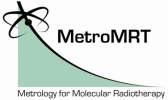WP1: Activity measurements for molecular radiotherapy
Most radionuclides used as radiopharmaceuticals for molecular radiotherapy applications are high-energy-beta or alpha emitters. Mostly they are conditioned as chemically linked to specific organic molecules (antibodies, peptides, etc.) able to target the tumour cells. These molecules are dissolved in an aqueous solution. Recent developments led to the fabrication of microspheres of 90Y. These are presently the only radionuclide to be used in this application. These microspheres are of different nature according to the manufacturer (e.g. glass (TheraSphere®) or resin (SIR-Spheres®)). These new radiopharmaceuticals are produced in suspension in pure water leading to specific standardisation problems, (e.g. homogeneity of the radioactive solution), both for primary measurements and for transfer calibration and measurement at the hospital that need to be addressed.
A promising new primary measurement method, called TDCR Cerenkov, is based on the detection of the Cerenkov photons created by the electrons produced in the decay of the radionuclide in the solution, with an energy sufficiently high for their speed to be higher than light celerity in that medium. The main interest of this method lies in the limited handling of radioactive sources (no preparation such as mixing with scintillating cocktail for liquid scintillation measurements). A second interest lies in the intrinsic energy threshold which permits discriminating low-energy radioactive impurities in the measurement. This threshold is at around 260 keV in aqueous solutions. This method should also minimise the influence of possible gamma-emitting impurities. Preliminary studies of the TDCR Cerenkov technique (Kossert, 2010 and Bobin et al., 2010) suggest that the uncertainties of the administered activity to patients can be significantly reduced. This will provide a means of ensuring that the activity is determined within recommended (European Pharmacopoeia) thresholds, i.e. ±10%.
Knowledge of the shape of the beta spectra for beta-decaying nuclides is required for the modelling of light emission used in the TDCR Cerenkov method to establish a relationship between the detection efficiency and the experimental TDCR ratio. This is also required for the accurate determination of the dose delivered within the tumour and the rest of the body, which is essential to ensure the efficacy and the safety of any treatment using ionising radiation.
Task 1.1: Development of the TDCR-Cerenkov technique for direct standardisation of radiopharmaceuticals
The aim of this task is to develop the primary activity measurement method based on the Cerenkov emission in aqueous solutions using conventional TDCR apparatus (after possible adaptation) for the standardisation of high-energy beta-emitting radiopharmaceuticals. It is intended to establish a general analytical model, similar to the TDCR model used for liquid scintillation that is valid for any TDCR measuring device. To this end, several specific effects have to be investigated (e.g. non-isotropic light emission, shape factor functions for beta spectra, optical properties of the detector components for Cerenkov light spectral bandwidth).
Task 1.2: Development of standardisation and transfer methods for 90Y microsphere samples
The aim of this task is to develop primary activity standards of 90Y microspheres and the protocol for transferring them to end-users in hospitals. The development of the standardisation will be based on the extension of the TDCR-Cerenkov models to this particular case. The transfer protocol concerns the calibration of radionuclide calibrators (re-entrant ionisation chambers) for vials filled with microspheres in water. For both objectives specific challenging problems are to be addressed due to the fact that the radioactive source is not a homogeneous aqueous solution as in usual practice but radioactive microspheres (glass or resin) dispersed in water which gradually deposit, more or less slowly according to the type of microsphere, at the bottom of the vial immediately after shaking.
Task 1.3: Determination of beta spectra
The aim of this task is to get a better knowledge of the shape of the beta spectra, especially in the case of forbidden transitions. The choice of the experimental technique and its implementation are essential. The study of the shape of beta spectra requires an energy resolution better than 5%. A meticulous study of the response function of the detector will be necessary to make sure that the experimental spectra are not distorted by the detection process. The analysis of collected data and the realisation of Monte Carlo simulations can allow us to understand all the phenomena which can distort the measured spectra. This work will complete on the experimental side a theoretical work started at CEA on the calculation of beta spectra.
For more information: Contact Vere Smyth

